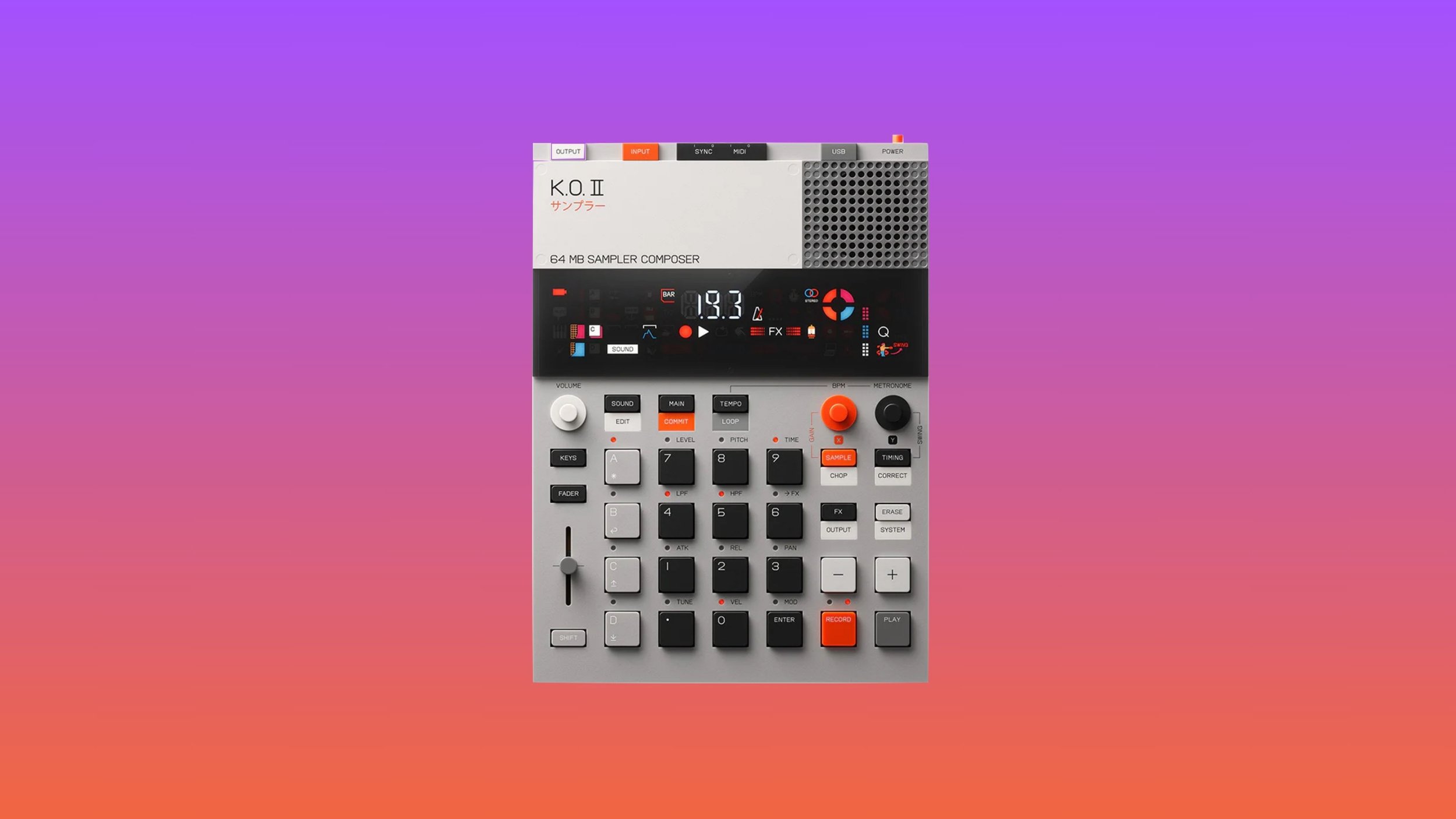EP-133 K.O. II Review: Meet Teenage Engineering’s Playful Sampler

Teenage Engineering has made a name for itself by designing gear that’s both playful and powerful, with a distinct design language that’s just as much part of the experience as the sound itself. From the cult-classic OP-1 to the wildly portable Pocket Operators, their products often blur the line between instrument, toy, and professional tool. With the EP-133 K.O. II, Teenage Engineering steps into new territory: a standalone sampler and groovebox that feels like a natural evolution of their Pocket Operator line, but grown up and fully stage-ready. In this review, I'll dive into what makes the K.O. II unique: its sound character, sampling workflow, live sequencing power, and overall design. Whether you're considering it as a first groovebox or as a lighter alternative to bigger samplers like the SP-404MKII or MPC One, I'll help you figure out if the EP-133 fits your creative style—or if its minimalism might leave you wanting more.
Disclosure: This post contains affiliate links. If you buy something through these links, I may earn a commission at no extra cost to you. As an Amazon Associate, I earn from qualifying purchases.
The Sound: Punchy, Playable, and Full of Character
At its core, the EP-133 K.O. II isn’t trying to deliver pristine, studio-polished sound—and that’s exactly the point. The samples you load or record through it take on a raw, punchy edge that feels alive and energetic straight out of the box. Whether you’re chopping up drum breaks, layering synth hits, or working with dusty lofi textures, the K.O. II adds a slight grit and compression that gives everything a bit of attitude without making it sound crushed or unusable.
A lot of that character comes from the built-in effects, which are simple but incredibly effective. You can easily add dirt, reverb, delay, or bitcrushing without getting bogged down in tweaking endless parameters. Effects feel like a core part of the sound shaping here—not an afterthought—which makes it fast to move from a clean sample to something with real vibe.
If you're coming from a background of slick DAW production, the K.O. II might initially sound rougher around the edges. But for beatmakers who want immediacy and energy over sterile perfection, the EP-133 captures the spirit of old-school samplers better than many boxes that cost a lot more.
Sampling and Workflow: Quick, Flexible, and Fun
Sampling into the EP-133 K.O. II is built around one core idea: keep it moving. Whether you’re recording through the line-in, the built-in mic, or loading samples over USB, the process is fast and designed to minimize friction. Once a sound is captured, you can immediately chop it, assign slices across the pads, and get straight into sequencing without any complicated setup. It feels like a device built to keep you in flow, not one that demands menu-diving or second-guessing.
One of the K.O. II’s coolest tricks is how resampling is baked right into the workflow. After you apply effects, pitch changes, or layer multiple sounds, you can easily bounce them down into a fresh sample slot. It’s an old-school technique that encourages creative sound mangling—and it fits perfectly with the box’s gritty, spontaneous vibe. Punch-in effects and quick tuning also make it easy to transform simple ideas into textures that sound much bigger than the source material.
If there’s a limit here, it’s the relatively basic sample management. You won’t find deep multisample mapping, detailed crossfades, or fine-grained editing tools. The K.O. II is built for fast, hands-on creativity, not for meticulously sculpting every detail. If you approach it like a musical sketchpad rather than a precision editing station, it feels incredibly freeing—and very hard to put down.
Sequencing and Live Performance: A Beatmaker’s Playground
The EP-133 K.O. II really comes alive once you start sequencing. With its 64 responsive pads and intuitive layout, it’s designed to get you banging out beats fast. You can record patterns in real time, step-sequence them, or mix and match approaches depending on your workflow. The pads aren’t velocity sensitive, but the immediacy of the grid more than makes up for it—you can quickly layer up kicks, snares, hi-hats, and chops without ever feeling like you’re fighting the machine.
Where the K.O. II really flexes its personality is in performance tools. Parameter locks allow you to tweak effects, pitch, or volume per step, creating grooves that evolve and twist without needing deep automation. Live effects like stutters, fills, and punch-in performance FX are just a button press away, making it easy to transform a simple loop into something dynamic and unpredictable. It’s the kind of setup that naturally encourages jamming rather than overthinking, which feels refreshing compared to more rigid grooveboxes.
Because patterns can be easily chained, muted, and rearranged on the fly, it’s just as easy to build full tracks as it is to get lost in beatmaking. If you like your grooveboxes to feel like an instrument instead of a spreadsheet, the K.O. II delivers that old-school fun in a very immediate, tactile way.
Design and Limitations: Brilliantly Simple, but with Caveats
In typical Teenage Engineering fashion, the design of the EP-133 K.O. II is minimal, clever, and immediately inviting. It’s slim, light, and the 64-pad layout makes a strong first impression—especially if you're used to smaller samplers or cramped interfaces. Everything feels purposefully laid out: pads for immediate playing, simple buttons for key functions, and a clean screen that gives you just enough information without overwhelming you. It’s a device that’s clearly meant to be played, not endlessly programmed.
That simplicity, though, comes with some trade-offs. The lack of velocity-sensitive pads might be a sticking point if you’re used to more expressive machines like the MPC or SP-404MKII. And while the resampling workflow is excellent, the sample storage isn’t massive, so you’ll probably be curating your sounds carefully rather than hoarding libraries. Editing is also intentionally streamlined—great for creativity, but not ideal if you want deep control over every tiny detail of your samples.
Overall, the K.O. II feels like a statement: this is a beatmaker’s box, not a micro-DAW. If you embrace its limitations and lean into its fast, tactile workflow, it’s a joy to use. But if you’re the kind of producer who needs complex editing, detailed sample layering, or high-end build quality, you might find yourself wishing it had just a little bit more under the hood.
Alternatives to the EP-133 K.O. II
Teenage Engineering PO-33 K.O.
If you love the vibe of the EP-133 but want something even more stripped down (and ultra-portable), the PO-33 K.O. is still a great little sampler. It offers basic sampling, simple sequencing, and a surprisingly fun punch-in effects system—all in a tiny handheld form factor. It’s way more limited in memory, pads, and live performance control compared to the K.O. II, but for spontaneous creativity and raw lofi fun, it still holds up.
Korg Volca Sample 2
Another solid option if you're looking for an affordable, portable sampler is the Volca Sample 2. It trades deep performance tricks for a simple, straightforward sequencing style and comes loaded with a surprisingly usable set of stock samples. It doesn't have the grit or real-time playability of the K.O. II, but for fast sketches, drum programming, and learning the basics of sample-based music, it's still a great choice—especially at the price point.
Elektron Digitakt II
If you're ready to level up from the K.O. II's minimalism into something much deeper (and more expensive), the Elektron Digitakt II offers full-featured sampling, deep sequencing, and powerful live performance tools. It’s much heavier on the workflow side—you'll need to invest time learning it—but it rewards you with far more sample memory, detailed control, and the kind of polish you expect in professional gear. It's not as immediate or playful as the K.O. II, but if you want a serious sampler that can grow with you, it's one of the best options out there right now.
Final Thoughts: Is the EP-133 K.O. II Right for You?
The EP-133 K.O. II is a perfect example of what Teenage Engineering does best: taking the spirit of classic beatmaking and packaging it into something fun, fast, and playable. If you want a sampler that feels alive in your hands, encourages real performance, and keeps the technical barriers low, it’s an incredible tool. The gritty character, the instant resampling tricks, and the 64-pad layout all combine to make beatmaking feel exciting rather than clinical. It’s a machine that rewards creativity and spontaneity—not one that expects you to plan everything in advance.
That said, it’s not aiming to be a deep, all-in-one sampler like a Digitakt or an MPC. If you need huge storage, advanced sound design tools, or velocity-sensitive pads, you’ll probably run into its limits fairly quickly. But if you’re looking for a groovebox that’s all about capturing ideas, jamming, and staying inspired, the EP-133 K.O. II delivers that feeling better than almost anything else in its range. It’s playful, powerful, and just serious enough to be your main portable sampler if you embrace what it’s built for.
Disclosure: This post contains affiliate links. If you buy something through these links, I may earn a commission at no extra cost to you. As an Amazon Associate, I earn from qualifying purchases.
